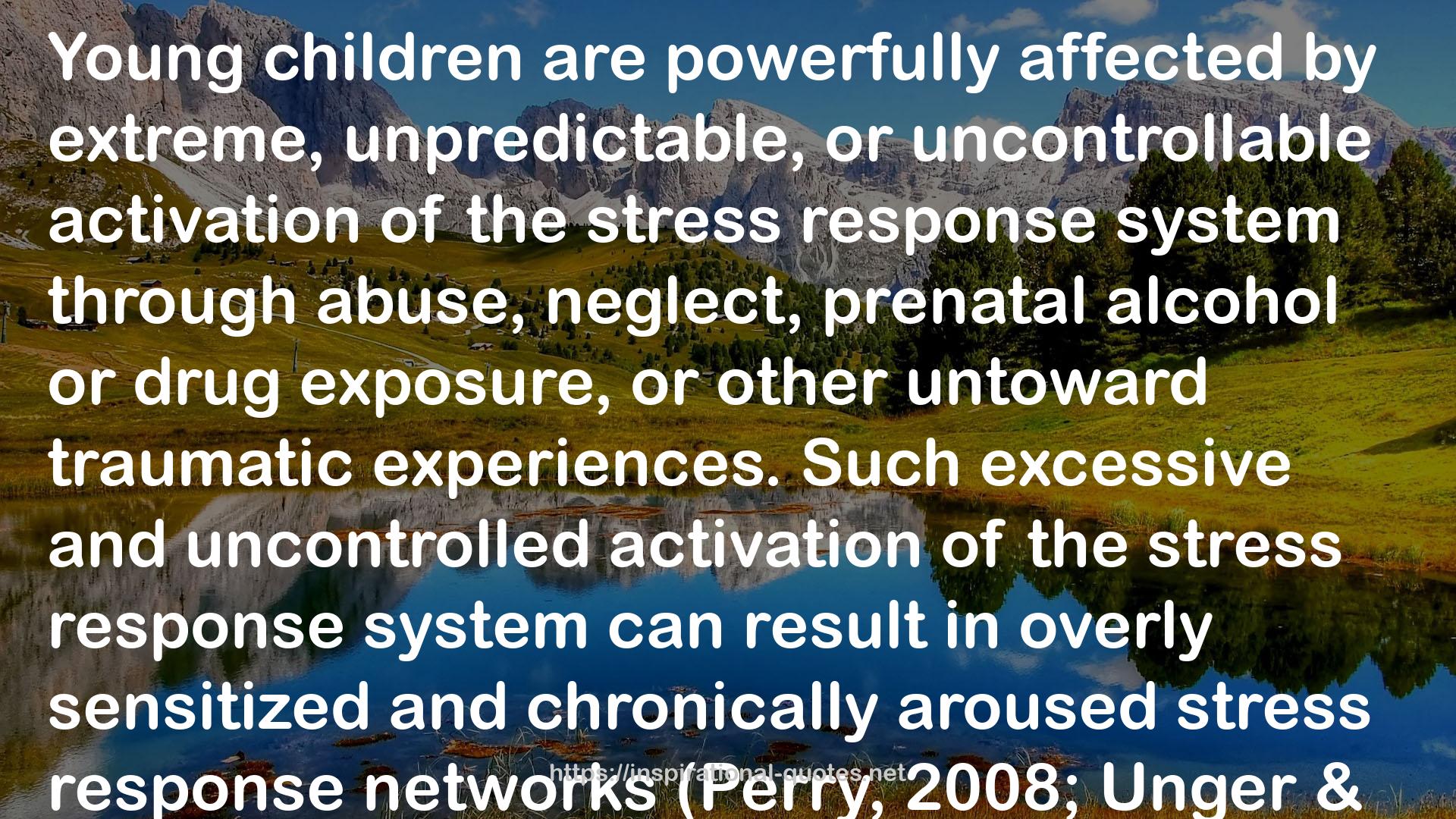1
" Young children are powerfully affected by extreme, unpredictable, or uncontrollable activation of the stress response system through abuse, neglect, prenatal alcohol or drug exposure, or other untoward traumatic experiences. Such excessive and uncontrolled activation of the stress response system can result in overly sensitized and chronically aroused stress response networks (Perry, 2008; Unger & Perry, 2012). The resulting impact on brain architecture can adversely affect cognitive, emotional, behavioral, social, sensorimotor, and physical health problems (Anda et al., 2001; DeBellis et al., 1999; Delima & Vimpani, 2011; Felitti et al., 1998; Perry, 2006, 2008, 2009; Perry & Dobson, 2013; "
― Cathy A. Malchiodi , What to Do When Children Clam Up in Psychotherapy: Interventions to Facilitate Communication
2
" The multiple consequences of early child maltreatment call for early identification and intervention with strategies that are effective to children with poorly developed cognitive and verbal abilities. Symptoms mediated through the regulatory neural networks originating in lower brain regions are far less responsive to treatment interventions using verbal, logical, rational, or even emotionally expressive treatment modalities. This is also true of play therapy strategies utilizing these methodologies. van der Kolk (2004) pointed out that traumatized individuals show little activity in the left hemisphere, particularly in language areas, resulting in decreased capacity for planning and analyzing while displaying excessive activity in the right limbic hemisphere, suggesting excessive emotional experience, but no ability to communicate it or understand it. Not surprisingly, such individuals respond poorly to cognitive, verbal, and multimodal treatment designs due to their self-regulatory deficits and language-based limitations. "
― Cathy A. Malchiodi , What to Do When Children Clam Up in Psychotherapy: Interventions to Facilitate Communication
4
" Speech and language development interconnects with all other facets of child development, including physical, cognitive, social, and emotional domains. Each domain affects and is affected by all other domains, assuring that language development and functioning will be altered by trauma. In fact, a history of maltreatment places a child at high risk for numerous speech and language problems, including language production, articulation, language comprehension, and school readiness (McConachy et al., 2013; "
― Cathy A. Malchiodi , What to Do When Children Clam Up in Psychotherapy: Interventions to Facilitate Communication
5
" bottom-up modalities (primary sensory, somatic, movement, rhythmic) help establish basic homeostatic stability will top-down treatments such as insight, reflection, trauma integration, narrative development, social development, or affect enhancement be effective (Kliem & Jones, 2008; Perry, 2008, 2009). "
― Cathy A. Malchiodi , What to Do When Children Clam Up in Psychotherapy: Interventions to Facilitate Communication
7
" Children requiring primary somatosensory interventions are likely are to display frequent sensory misperceptions, appetite, feeding, or metabolism problems, persistent somatic or visceral dysregulation, fine or gross motor movement or balance impairment, sleep problems, or endocrine issues. Such anomalies will be in excess of normal for the developmental age. The treatment protocol will emphasize somatosensory experiences, self-regulation, and movement interventions, all of which provide the appropriate nature and pattern of activation to help these lower networks change. Language, reasoning, logic, and understanding are de-emphasized in favor of core regulatory functions. The somatosensory activities must be carried out in a richly positive relational context (Core Element 3) as the activity itself is insufficient for positive developmental growth and neural organization. Sensory activities must be planned and scheduled at specific times each day for short periods of about 10 to 15 minutes. Pick activities the child will enjoy, as children will not repeat those that are unrewarding. The activity, environment, and method may need to modified periodically to keep them fresh, attractive, and fun. Never force the child into an activity if he or she is uncomfortable with it. Take baby steps if the child is uncomfortable. Find safe ways for the child to engage in and experience the activity. "
― Cathy A. Malchiodi , What to Do When Children Clam Up in Psychotherapy: Interventions to Facilitate Communication
9
" The primary focus is empathy, attachment, attunement, and positive emotions related to interpersonal relationships. The therapist must emphasize face-to-face gaze, eye-to-eye contact, matching facial expression, matching tone of voice, and using reflective responses. Also effective are play and play activities, such as singing, music, enjoyable social activities, playing with a pet, telling stories, special handshakes, playing with stacking blocks, Legos, or manipulatives, games that allow taking turns, playing with a cardboard box maze, playing social games (Red Light, Green Light; Mother, "
― Cathy A. Malchiodi , What to Do When Children Clam Up in Psychotherapy: Interventions to Facilitate Communication
10
" Trauma-related manifestations of impaired cortical development or functioning may include communication disorders, understanding causality, motivation, academic problems, conservation of matter, ordering events, classifying, forming hypothesis, problem solving, or moral and ethical thinking. "
― Cathy A. Malchiodi , What to Do When Children Clam Up in Psychotherapy: Interventions to Facilitate Communication
16
" Watts-English, Fortson, Gibler, Hooper, & DeBellis, 2006). Further compounding this limited verbal and conceptual ability is the observation that children from low verbal families develop language skills even more slowly (Hart & Risley, 2003). This results in protracted immature language usage, fewer words, shorter sentences, and the consideration of fewer details than children from high verbal families (Papalia & Olds, 1979). "
― Cathy A. Malchiodi , What to Do When Children Clam Up in Psychotherapy: Interventions to Facilitate Communication

